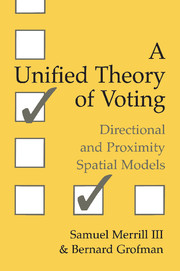Book contents
- Frontmatter
- Contents
- List of Tables and Figures
- Acknowledgments
- 1 Introduction
- Part I Models of Voter Behavior
- 2 Alternative Models of Issue Voting
- 3 A Unified Model of Issue Voting: Proximity, Direction, and Intensity
- 4 Comparing the Empirical Fit of the Directional and Proximity Models for Voter Utility Functions
- 5 Empirical Model Fitting Using the Unified Model: Voter Utility
- 6 Empirical Fitting of Probabilistic Models of Voter Choice in Two-Party Electorates
- 7 Empirical Fitting of Probabilistic Models of Voter Choice in Multiparty Electorates
- Part II Models of Party or Candidate Behavior and Strategy
- Postscript
- Appendices
- Glossary of Symbols
- References
- Index
4 - Comparing the Empirical Fit of the Directional and Proximity Models for Voter Utility Functions
Published online by Cambridge University Press: 04 December 2009
- Frontmatter
- Contents
- List of Tables and Figures
- Acknowledgments
- 1 Introduction
- Part I Models of Voter Behavior
- 2 Alternative Models of Issue Voting
- 3 A Unified Model of Issue Voting: Proximity, Direction, and Intensity
- 4 Comparing the Empirical Fit of the Directional and Proximity Models for Voter Utility Functions
- 5 Empirical Model Fitting Using the Unified Model: Voter Utility
- 6 Empirical Fitting of Probabilistic Models of Voter Choice in Two-Party Electorates
- 7 Empirical Fitting of Probabilistic Models of Voter Choice in Multiparty Electorates
- Part II Models of Party or Candidate Behavior and Strategy
- Postscript
- Appendices
- Glossary of Symbols
- References
- Index
Summary
All politics … are based on the indifference of the majority.
James Reston, The New York Times (June 12, 1968)Discriminating between Models
We may assess a voter's evaluation of a candidate through either (1) voter choice, i.e., whom the voter votes for, or (2) voter utility, i.e., the voter's quantitative evaluation of the candidate on some scale. Whom one votes for may be the ultimate question, but utility – which relates to enthusiasm for (or against) a candidate – has important secondary effects. For example, if the value attached to getting one's preferred candidate elected is high enough, the citizen may be motivated not merely to vote but also to participate in politics as an opinion leader, activist, or financial contributor. Moreover, such participatory and contributory activities on the part of one voter may well influence how others vote.
Discrimination between competing models of voter choice may appear more difficult than discriminating among competing models of voter utility, because focusing only on the either-or decision of voter choice makes use of only some of the information available to us about the shape of voter preferences. On the other hand, as we shall see in Chapters 6 and 7, statistical testing of voter choice models may avoid certain methodological difficulties that plague attempts to test models of voter utility. Models that make clearly different predictions about the shape of voter utility functions may have much greater predictive overlap in terms of voter choice (especially for only two alternatives); however, as we will see in Chapter 10, different models may make very different predictions about the spatial configurations of candidates or parties as they respond to voter evaluations.
- Type
- Chapter
- Information
- A Unified Theory of VotingDirectional and Proximity Spatial Models, pp. 52 - 66Publisher: Cambridge University PressPrint publication year: 1999



